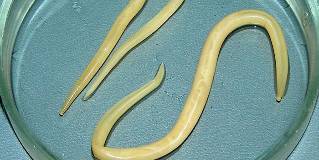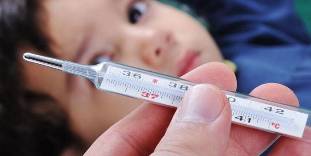The danger of the penetration of worms in the body accompanied by a man, from the first days of life. Adults, the elderly, adolescents and children infected via hands, food and water. Problem worm infestation are easily confused with diseases of the gastro-intestinal tract. At the onset of symptoms in infants it is important that the tests and see a doctor. How to bring worms in a child?

What to look for worms in children
The eggs of worms group of helminth share the child's body through food and water. The main causes of worms eating unwashed fruits and vegetables. Dirty hands, undercooked food, unclean water, flies – all is dangerous. Tapeworms come together with the infected meat, and nematodes are transmitted through skin contact with dirty surfaces (if walk on the earth). When such foods inside can occur enterobiasis (pinworms size up to 2 cm). Roundworm is transmitted to animals.
What is dangerous
Worms in children is dangerous because depriving the body of nutrients. The worms eat the useful elements and produce waste, which has a toxic effect on: this can lead to the development of allergic reactions. How dangerous are worms in the tissues of the internal organs? If parasites in children planted on the fabrics, it violated the integrity of the walls, which can cause bleeding, various diseases (intestinal obstruction), worsening health (often disease of acute respiratory infections, SARS). Threats to life are worms in the lungs.
Types of worms in children
The child's body can become damaged by parasites, such as small size and big. The incubation period of the helminths may vary from 1-1, 5 months. It is very important to determine the type of worms, because this depends on what medications should be taken. Common varieties of worms in children:
- tapeworms: no cestodes tapeworm, dwarf tapeworm, the tapeworm, Echinococcus;
- segmented worms: with annelid;
- roundworms: Trichinella, pinworms, vlasoglav, nematodes, roundworms;
- koljuchegolovye worms: skrebat;
- flatworms: trematodes, flukes.
How to find out whether the child has worms
Many parents are interested in, how to detect worms. Laboratory-diagnostics to help identify the disease and is a reliable method for the determination of helminthiasis. Early detection of the infection as soon as prescribed course of treatment with medications that help protect the baby from unpleasant consequences. In some cases, to diagnose the disease can be visually: Kale is the presence of worms. With the defeat of the body of the helminth infections may include the following features:
- frequent headaches or dizziness;
- grinding teeth while sleeping (bruxism);
- severe fatigue;
- digestive disorders (constipation or diarrhea);
- the excessive strengthening of the appetite, or not at all;
- pain in the navel or across the abdomen.

A blood test
Prevention is reviewed every year for worms in children, especially if the child goes to kindergarten or school. The main advantage of the ELISA blood test for helminth eggs detection of worms at an early stage. When you perform a ELISA test should not eat or drink for about 8 hours, use water in small quantities. Early in the morning on an empty stomach to take blood from a vein. Doctors examine the presence of antibodies to the parasite. Antibodies – immunoglobulin protein, which is produced by the appearance of parasites in the body. Detection of protein analysis the results of the said disease.
Can there be worms in children
The parasite can occur in infants. To get they can be at the moment of delivery, or as older children, through contact transmission (hands). The situation is complicated by the fact that babies don't have a strong immune system. Their bodies can not withstand the load in the form of the parasite, and depleted two times stronger than adults. Worms in children (8-12 months) can also lead to artificial feeding. Doctors say that the best prevention of infection is the feeding of mother's milk.
Signs of worms in children
Each variety of worms is characterized by their typical symptoms, but it is possible to share the most common symptoms of worms in children, among which are: anxiety, irritability, pallor, and dry skin. The baby begins to act up, he appeared circles under the eyes. To see them, parents should go to the doctor until it was too late. Among the signs of helminthiasis release:
- the lack of weight;
- the anus is reddened;
- fever;
- dry cough and colds;
- abdominal pain, head.
The first signs
To identify the parasitic infection is not easy. The parents of the child should alert to changes in behaviour: he looks troubled and anxious, may be present in weakness, a rash, reduced immunity, worsening of appetite or greatly increased. Early symptoms of helminthiasis violation of the chair, which is manifested in the then diarrhea, then constipation. Other first signs of worms in children:
- sudden nausea;
- increased salivation during sleep;
- attacks of abdominal pain of uncertain localization;
- the anus begins to itch (pinworm);
- fatigue;
- a bad dream.
Temperature
The temperature rises to worms in children is not the primary symptoms of infection, but are considered to be involved in the symptom. Why is the temperature rising? If the body is present in ascariasis (infestation of parasitic roundworms), the eggs are observed in organs and tissues. A huge number of them cause infection, which is fever. Temperature when the round worms, because the muscle pain and swelling of the face. Temperature in worms rises to subfebrile, i.e. up to 37-37,2°C.
Vomiting
Worm infestation in children can cause vomiting and foamy white. The process develops gradually. The initial stage of the disease lasts for 3 weeks. Next is a dry cough and a rash similar to hives. Vomiting occurs of worms in a child, as well as other unpleasant symptoms: excessive salivation, anxiety, and nausea. The first appearance of white foam gag to analyze the feces detection of traces of worm eggs.

Diarrhea
Many diseases, gastro-intestinal tract characterized by the same symptoms as the risk of helminth infection. The patient may experience constipation, diarrhea, nausea, vomiting. Parasites are irritating to the mucous membranes of the intestine produces inflammation and diarrhea worms in children. A reliable indicator of worms is a constant feeling of hunger. The first thing you need to do this symptom is to test the intestinal area. When helminthiasis palpation causes pain, and you can look for worms.
Treatment of worms in children
If the characters take the child to the doctor. Pediatrician to arrange a pre-inspection, write the direction of the analysis, prescribe treatment, based on the history, the child's age, weight, extent of infection. There are many effective drugs against the entrenched parasites in the body. Treatment of worms in children can occur with medication and traditional methods.
System
The standard treatment is obliged to carry out preparatory measures. This pediatrician appointed by the plant oil and non-hazardous sorbents. With their help the body is cleared of infectious slag worms and toxins. The duration of the preparatory stage is five to seven days, after which together with the faeces released part of the parasitic worms. Those who remain, waiting for treatment against worms drugs can cure the disease. How to fight parasitic worms in 3 steps:
- The preparatory stage consists of reception 1 teaspoon before meals flax oil three times a day and sorbent 1 tablet after a meal.
- Then there are pills for worms in children prescribed by your doctor.
- After the battle to take medications, to maintain paid.
Drugs against worms for children
How to check and bring the worms in a child? You need to contact your pediatrician, who will help you choose effective drugs. The most common drugs against worms for children is a paralytic effect on the muscles of the parasite, which leads to their destruction, and possess a wide spectrum of action.
Folk remedies
Widely popular methods of treatment is not, because of the devastating, but mild effect on the human body, unlike drugs. After the expulsion of the worms need to be sure that a person is allergic to herbs or strange configuration, otherwise the treatment may cause damage. What to give children for worms, and how to get rid of them? Herbal treatment for worms in children traditional methods to perform participation in the infusions and decoctions of the following plants:
- tansy;
- garlic;
- dandelion root;
- red clover;
- yarrow;
- thyme;
- calamus root;
- wormwood.
Diet
Treatment must be combined with the diet of worms in children, designed for quick removal of parasitic worms. To improve children's diet in worms differs from that of adults, it is more the yogurt contains pieces of fruit and berries. Take care to exclude from the diet of harmful products, soda, sweets. Examples of diet against worms:
- Get rid of the tapeworms (tapeworm wide, ascending or pork tapeworm) can help daily consumption of pumpkin seeds for 7 days on an empty stomach.
- Liver parasite cleanse the diet, with the use of rice-water, corn or pumpkin porridge, berries, vegetables, fruits.
- Eliminate the symptoms of helminthiasis in the blood to help nuts, brown bread (the crust), sea kale.
Prevention of helminthiasis in children

The most important prevention of worm infestation has complied with the right measures of personal hygiene. Not all adults can take care of himself, but what about the kids? It is the duty of parents to teach and train the little man to personal safety, which is preventive measures is not just worms. To reduce the risk of infection of parasitic worms you will need:
- before eating, wash your hands;
- pour over boiling water or just wash to apply to the table of fruits, vegetables, citrus fruits, berries, herbs;
- drink only boiled, mineral or treated water and raw;
- there is high-quality products;
- protect yourself from insects;
- do not bathe in unfamiliar places, especially in the summer.




































